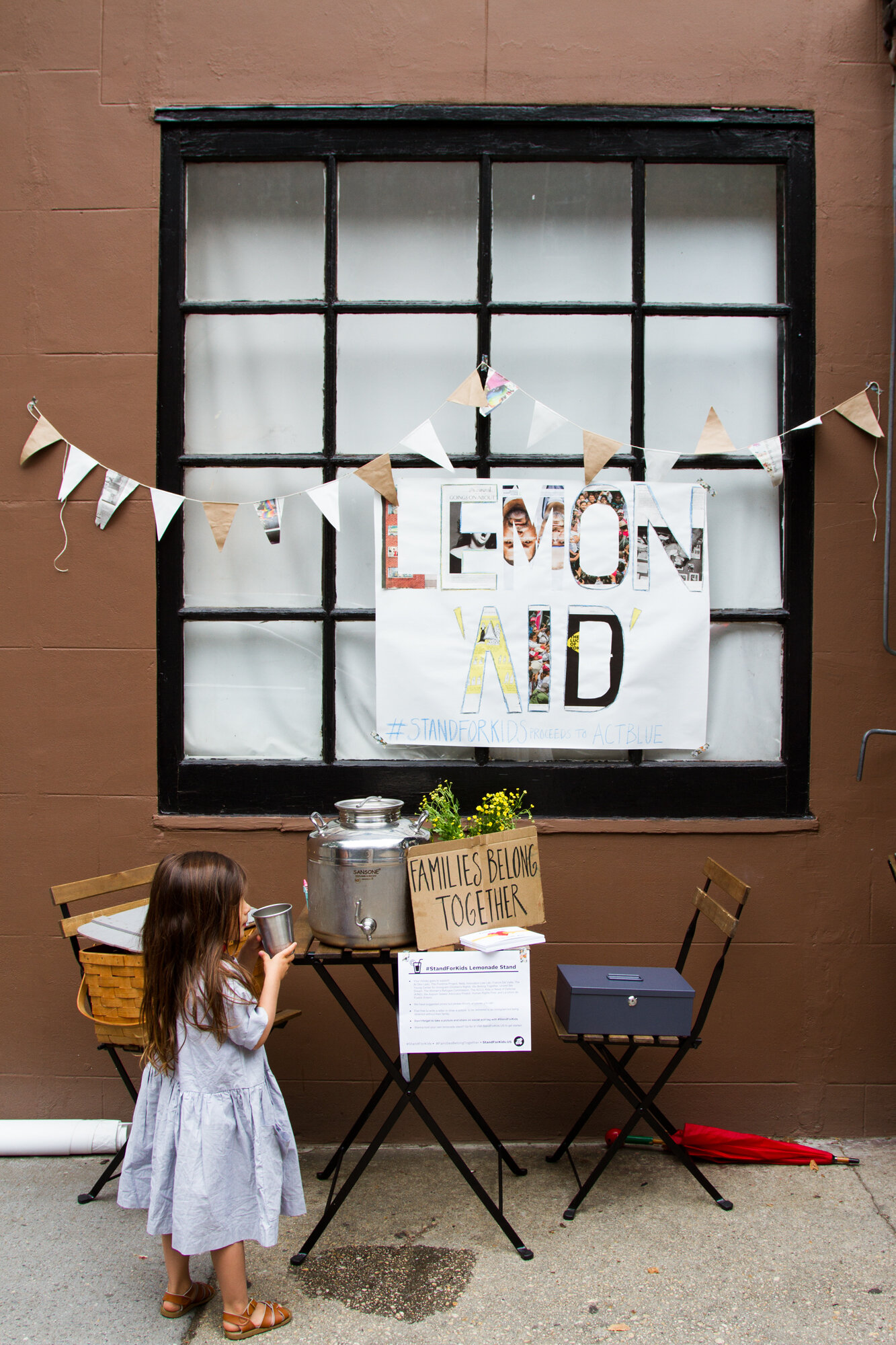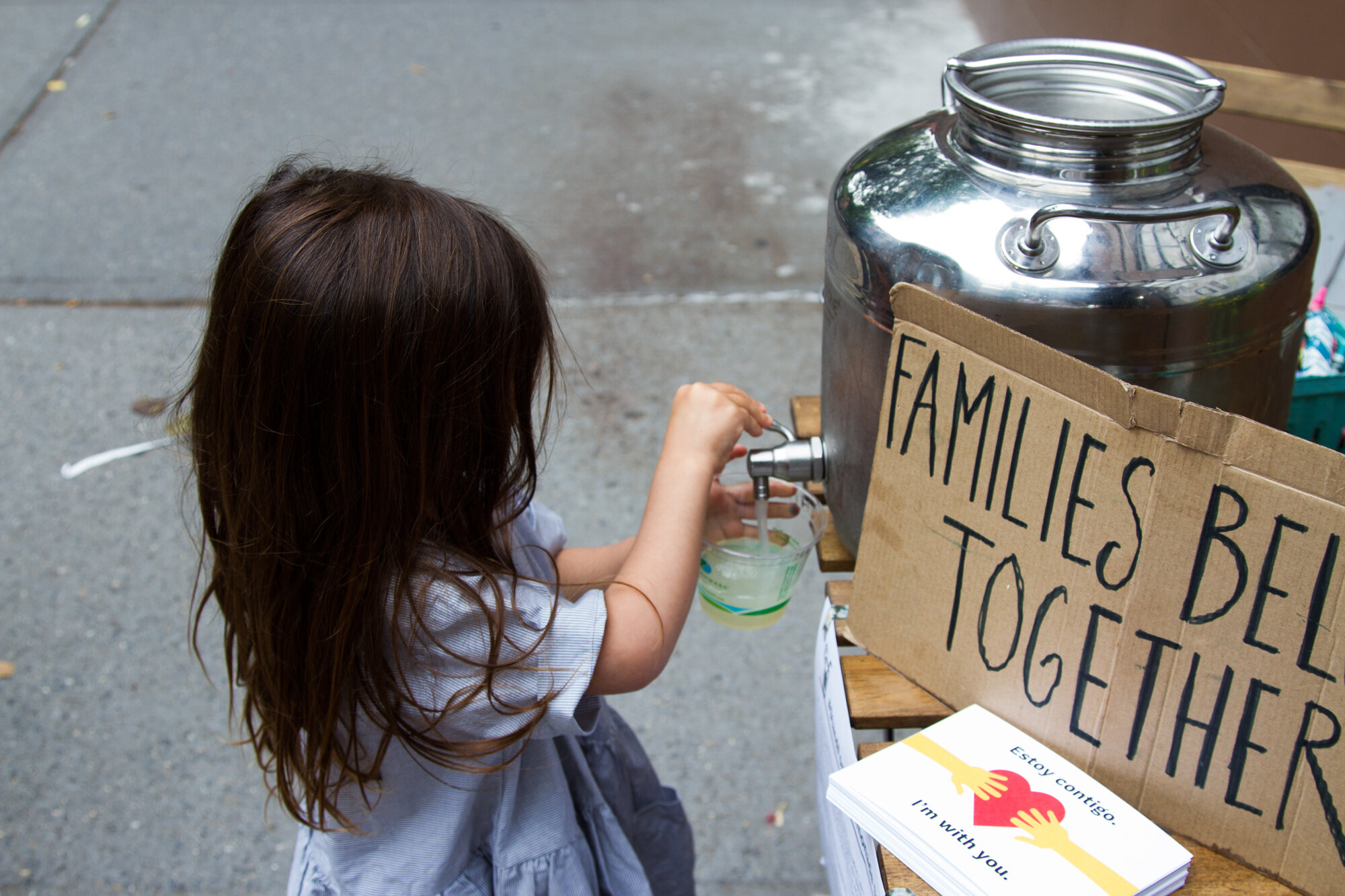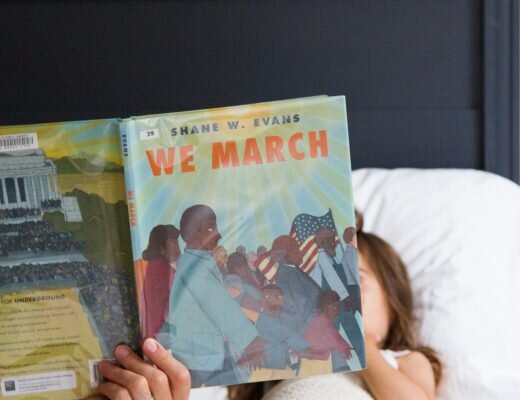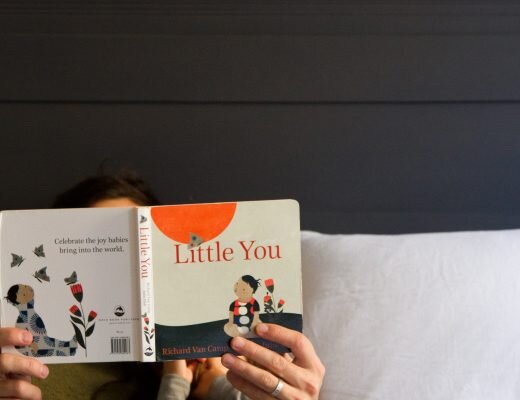 Over the weekend we hosted a lemonade stand with Faye and Silas and dear friends at one of our favorite neighborhood shops. The café, Poppy’s, generously provided the kids with a gigantic cooler of lemonade and for three hours the kids collected donations to send along to organizations helping families impacted by the current crisis at America’s southern border. (We raised $432.00!) The stand felt like such a sweet and positive way to get kids directly involved in making a difference for kids in need.
Over the weekend we hosted a lemonade stand with Faye and Silas and dear friends at one of our favorite neighborhood shops. The café, Poppy’s, generously provided the kids with a gigantic cooler of lemonade and for three hours the kids collected donations to send along to organizations helping families impacted by the current crisis at America’s southern border. (We raised $432.00!) The stand felt like such a sweet and positive way to get kids directly involved in making a difference for kids in need.
Here’s the thing: The kids get it.
These are complex topics in complex times, but over and again I’ve found that kids are really remarkable at understanding basic issues of social justice. Better, I’d venture, than most adults. And once again, I’m reminded that the onus is on me (and James)—and all parents—to have these conversations.
As always, we’ve found it most comforting to turn to books.
Faye and Silas’s caregiver, Zaina, is an immigrant from Syria. Like many Syrian immigrants, she came to the US to escape the turmoil of the Syrian civil war. This winter when I struggled with finding a way to discuss why Zaina can’t easily return to visit her family overseas, we read the very beautiful children’s book The Journey by Francesca Sanna. It follows the story of a young family that loses their father and is forced to leave their home. On their journey they encounter and escape from border guards. As the family makes their way farther and farther from home, the reader witnesses their hope in the face of the unknown. Heartbreakingly, the book also provided excellent context for the refugee crisis happening right now in our own country. Discussing family separation at the hands of the border patrol in the US was particularly poignant—and yes, even scary.
It wasn’t super easy to talk about. I worried I would frighten Faye unnecessarily. I worried I was saying too much. When she asked with a quivering lip if someone was going to separate her from her parents, I did my best to reassure her. What an incredible privilege. Speaking to an undocumented friend of ours this week—the mother of two children born in the US— it was clear that my hesitation about scaring Faye was nothing compared to the task our friend faces. None of us can remain silent.
Below are a few ideas for talking to kids about the current crisis, and getting them involved in efforts to help.
Read a book: If you haven’t sought them out already, there are so many inspiring Instagram accounts related to kid lit and I turn to them again and again. Many of them offered invaluable advice this week. The Bookworm Club offered particularly helpful guides for deep reading with kids about issues of immigration and justice in particular. It outlined specific ways for reading that’s aimed at truly understanding, dissecting, and interpreting books. (It’s not enough just to have the books on our shelves, we need to really read them and talk about them in order for the work to get done.) The Conscious Kid is another source of excellent and daily inspiration for me. It includes book recommendations as well as general encouragement to dig deep into issues of racism and social justice. If you’re looking for another place to start, Common Sense Media compiled this list of Books to Help Kids Understand the Immigrant Experience. Finally, this week our friends at Stories Bookshop recommended Mama’s Nightingale: A Story of Immigration and Separation.
Host a sale: Raising money through entrepreneurial endeavors is perhaps a uniquely American answer to feeling helpless, but the lemonade stand we worked on over the weekend felt so great. It was such a positive way to get kids involved, yes, but it also felt great to be a parent, out on the sidewalk, connecting to friends and neighbors and perfect strangers. The #StandforKids initiative was designed around last weekend in particular, but there’s no reason why we can’t make this the summer of charitable Lemonade Stands more generally. Lots of resources on the Stand For Kids site.
Draw pictures/Send letters: A family of three little kids set up shop at our stand on Saturday and drew pictures on countless postcards to send to kids separated from their families. It was heartrending and warming to watch them work so diligently to share a bit of goodwill with kids in pain. If you’ve got little ones interested in sending notes to kids who need them, you can direct them here: Families Belong Together / National Domestic Workers Alliance c/o Purpose 115 5th Avenue, New York, NY 10011.
Protest, together: A national day of action and protest is being planned for June 30, 2018. Find an event near you, talk to your kids about why you’re going, and if it feels right for your kid and your family, bring them along.
Talk (and mostly listen): A reader comment below reminded me that what might matter most of all is to listen to kids when they express their fears. I think most parents would agree that we’d love to think about childhood as time of innocence. The truth is that that’s only ever part of the story. Just like adults, many kids need to grapple with all kinds of things that might make them sad or fearful. For all things parenting, I often turn to Janet Lansbury. I found this episode: When Children Ask About Death (or Other Heavy Topics) to be really helpful. Her overarching point is that we should allow kids to feel their full range of emotions, instead of telling them not to be afraid or that they don’t need to worry. Common Sense Media also breaks this down in their series: How to Talk to Kids About Difficult Subjects. Finally, I’ve returned over and again to this episode of This American Life: Birds & Bees.
What else? What are you guys talking about in your families?




22 Comments
On Wednesday, at the local library book sale, I found a copy of The Journey and quickly snagged it. Unfortunately, I was astonished to discover that, instead of having been donated by a town resident who perhaps no longer needed it, this beautiful and heart-breaking (and appropriately frank) picture book was being “weeded out” of the library’s own collection–oddly prematurely, I would argue. I know libraries have limited shelf space and that there are necessary methods for choosing what must go and what can stay, but I wish this one could have stayed on the shelves a little longer. Luckily, it’s at our house now, along with a copy of Shi-shi-etko by Nicola Campbell, also from the same sale. The latter is about residential schools and the forced separation of native children from their parents, grandparents, and other loved ones–and their entire traditional cultures–in the United States, Canada, New Zealand, and Australia. Such sorrows we humans visit upon each other. Without books like these–and conversations like yours–the risk is that we may not learn and we may not heal. And what a sorrow that would be.
I do not know what to say. It’s terrible what happens at your borders.
Protecting the state with such barbarous methods is evil.
Again, I couldn’t hold back tears and sobbing reading this. Lots of love to you Erin, thank you for your work today and always. Little bright lights in the darkness. I will do exactly the same this summer with my kid. This is my favourite post of yours ever.
After finding the Journey at our local library–and not glancing through it beforehand to prepare myself!–I began reading it to my 3-year old, who asked fearfully “Where did the mommy go?” I. I think I told her that the mommy had to stay behind but they would be looking for her, which was my frantic strategy in the moment. Moving forward, I fear creating nightmares, which I realize is a totally privileged position given those who live in waking nightmare. My capacity to reassure her that she is fine, and that I am not going anywhere, is one solution but it creates a different kind of privilege too, doesn’t it? That is, this reassurance then creates a barrier from having to truly feeling the pain of separation for others. But then, that is the world she has been born into…
I’m hoping that the June 30 march will feel like a slightly easier venue in which to frame this. In the end, I want to raise children who are conscious of social injustice and help them fight it. The question is how to prepare them to take that on with bravery and compassion without creating debilitating fear.
Hey there: This is tough for sure. Absolutely not trying to make you feel any worse, but I do think in some ways your story is a cautionary tale and a good reminder that as parents it can be really helpful to prepare a bit as we broach subjects that might be difficult for us, let alone for kids. In The Journey I actually really appreciated that ambiguity around the missing parent (it’s actually the father that the family loses, but the details don’t matter here). It helped me to explain to Faye that we’re not really sure what happened. That the father might have died or been unable to join the family and to talk about how that would make us feel. Then we talked about what the family did to feel safe and supported. For all things parenting, I often turn to Janet Lansbury. I found this episode (When Children Ask About Death… to be really helpful. The Common Sense Media How to Talk to Kids About Difficult Subjects might also be really helpful. It breaks things down according to the child’s age.
Oh, I think it must have been a different book, then. In any event, one about the mother who can’t come along as they leave a place of conflict. Yes, agreed that preparation is best! I’m not sure that my parenting moment was *so* incompetent that it’s a true cautionary tale (we had a good conversation during and after current events) but I did wish I had read the book first. I agree that the common sense page was really helpful for me in deciding to start a discussion and am a big fan of Janet Lansbury. I do think that there are some fundamental issues that remain challenging: first, that reassurance doesn’t work for all children (given the different forms of vulnerability in relation to the state, police, etc ) and second, that when we (which is such a complicated word when it comes to parenting, as it comes with many hidden assumptions) reassure our children, we invoke categories, distinctions, and structures that can potentially serve to help children fight those same structural inequalities but also have the potential (no matter how well-intentioned or prepared) to reinforce them. Let’s proceed with caution and grace.
For sure. Attempting to speak universally is nearly impossible and certainly different kids and families and circumstances require different approaches and different conversations. Not at all implying that your approach was incompetent. For my part, I feel like Janet’s discussion of the topic actually helped to free me a bit from feeling the need to reassure Faye, per se. It helped me to really value listening and admitting that I feel scared or unsure or doubtful sometimes, too.
Agreed! I had the same takeaway from raceconscious.org (which I think you have recommended before), that listening and admitting uncertainty (and even “failing” in front of our children) is all ok, and certainly preferable to avoidance.
thanks for raising a hard and important topic.
Yes, totally! Thanks for wading into it with me!
I think it’s interesting to note that while I have given a LOT of thought into how/what to shield my kids from (sex? death? violence? hate?) and then it’s introduced through something like a Disney movie.
The only thing I’d add to your well- thought out post, is that all kids are different. Faye might be able to handle it, but my daughter who is incredibly anxious (and older than Faye) absolutely could not. My son would digest the information totally differently. I do wish you’d add a post script that this is what you’ve found to work for your kids, but it’s not universally “correct” action for all kids.
Hey Amanda, for sure, all kids are different! I think what I’m trying to say here is that having honest and frank conversations with kids is really helpful and that there are ways to talk about tough stuff in totally age-appropriate ways and ways that bear in mind individual kids’ needs or boundaries.
What a great post. This is something I think about a lot these days. My kids are a bit older (9 and soon to be 12 years old), and this year has been a doozy for us in terms of talking about real issues, i.e., gun violence, black lives matter, womens rights, immigrant/refugee rights. But I think you are right: kids do get it. My 3rd grader wrote about her experience marching for gun safety in schools this past spring for a school assignment and it was really interesting to see what stood out for her at the march: the signs, the chanting, the student speeches. I hope it made a lasting impression on her as it did for me. Talking about family separation has been really hard. We won’t be able to march, but have been talking about other ways to act as a family. Thanks, as ever, for the inspiration.
Thank you so much for this. We don’t tend to shy away from difficult topics with our kids, but I’ve found myself uncertain how to describe what’s happening without scaring them. As usual, your practical, thoughtful approach has given me some great ideas. Since their dad arrived here as a three-year old immigrant, I also hope this leads them to better understand what it took for their grandparents to make the journey. I’m feeling less paralyzed and scared to start the conversation, so thank you for the inspiration and gentle nudge!
Hi Erin, I’m not convinced by the argument that discussing traumatic subjects with children is alright because with gaining awareness that is emotionally shocking they are suffering less than other children in worse situations. I’m also not convinced that they ‘get it’ because they appear to understand with wisdom. I would probably read books about child psychological and brain development to determine an age for these kinds of conversations. Further, female children are now getting their periods at age eleven. Introducing political or traumatic subjects early is another way of helping them to mature faster. I wonder if letting children enjoy the happy, present-focused state of consciousness that is characteristic of childhood learning will prevent against anxiety and depression later. I’m sure you’ll make the best decision for your children.
Hi Brianna, I think there are really age-appropriate ways to discuss difficult subjects with kids without traumatizing them and that it’s imperative that parents have honest, compassionate conversations with their kids. Totally recommend reading books on the subject if you’re not sure of the right approach for your own family.
I just haven’t read an argument from you stating why it’s imperative to have these conversations and that they don’t traumatise. Just creative thoughts. I love that you provide lots of resources. I need the argument first.
The world is complex. It’s often wonderful and carefree, but at one point or another all kids will come across some amount of hardship and many live it daily. For kids in the midst of these kinds of acute crises, or who live with the everyday trauma of things like poverty or racism, the toll is incredibly high. I’m not suggesting that the solution is to visit trauma on all kids, but teaching kids about the trials of other folks in gentle and sensitive ways is a first step toward a future of understanding, greater equity, compassion, and empathy. Kids are also incredibly perceptive. They *notice* inequity. They come across stories of hardship. They have questions. I think it’s a parents’ responsibility to talk with them about the things they encounter that they might have questions about.
Thank you Erin, your post inspired us to host a stand the day before and during the rally this weekend, and we raised & donated $500! It feels like a small thing to do and we need to keep the pressure up, but it was good to come together with our community. I agree that our impulse is to protect our kids from the onslaught of terrible news and realities, but more and more these days, I’m realizing what a privilege that is, and I’m wondering how much keeping them totally sheltered helps them and our society in the long run? I’m sure they can sense how occupied we are with news of terrible abuses of power even if we don’t discuss it with them directly. Kids seem to sense and process emotions in different ways. And I think that if they sense something is wrong, but we’re not talking about it . (in age appropriate ways) whether that can also be confusing and destabilizing. I also just feel that in this extreme moment in this country, we need to express solidarity with the most vulnerable in our society and show that expression to our kids, even if we are lucky enough to live in comfort. Again, I think there are ways to talk about it, and I think how we explain it depends on our child, their temperament and their age. I think writing/drawing messages of support to children at our border who are being treated poorly by our government is a place to start. I was heartened by how readily kids that came to the stand knew how to draw & write simple direct messages of empathy. We also have over a hundred postcards to send, I know the fight is not over, but this felt like a very powerful way to channel our energy, thank you again for sharing!
Yes, totally agreed, Lara.
I like how you’ve written here. I understand your perspective better. Thank you.
i have to disagree. i remember once playing with my parents in our front yard and a guy drove by, slowly, and my mom made an off-hand comment, “he must be looking for kids.” what she meant was that he was looking for HIS kids. she knew the man (i didn’t recognize him) and figured his kids were out in the neighborhood playing, and he was looking for them.
i was 5 or 6 and i assumed she meant he was looking for kids to abduct. i lived in a stable home in a safe neighborhood with no reason to fear abduction, but it was a constant fear through my entire childhood, stemmed from that comment.
i doubt faye and silas have questions about what’s happening at the border unless perhaps you read the new york times to them before bed?
i survived the virginia tech shootings. i won’t be talking to my kids about it until they’re much, much older. it’s not appropriate.
Hey Kristie, I’m not suggesting making off-hand comments to kids. This is about opening up mindful, age-appropriate conversations! We’re not quite at the age where we’re incorporating the New York Times into their bedtime stories (wink, wink), but Faye and Silas see signs of folks’ struggles all around them: from people begging for money on the subway, to people carrying protest signs, to billboards featuring kids who don’t have enough to eat, to storefronts and churches with posters on the windows welcoming immigrants…the patchwork of humanity is made up of both struggles and joys and they witness that. We don’t chat about foreign policy or intricacies of immigration law with our kids, but we do speak to them frankly about inequities that they witness on a daily basis. It’s my sincerest wish that our talking about these things gives them a framework of hope and determination and the belief that in spite of so much that’s wrong with the world, there are good people to be found everywhere.
Comments are moderated.